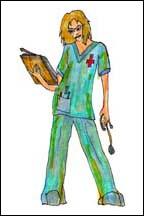Ask anyone, and you’ll hear that back pain is one of the most common reasons for missed work and a common reason for doctor’s visits. Many of us experience back pain at some point during our lives, yet do (and know) little to address the issue.
Myths on what back pain is and how to treat it are abundant. With the wrong information, you can harm yourself or live with the pain forever. Here are the top 10 myths:
Myth # 1: Since back pain is so common, diagnosis is easy to do.
There are a number of structures in the spine that can cause pain and they often overlap. In addition, there are other diseases and conditions that mimic back pain, explained Santhosh Thomas, Medical Director at Center for Spine Health.
“Diagnosis is not always easy, but reassurance and good medical advice may be in order,” said Deborah Venesy, M.D., from Cleveland Clinic’s Center for Spine Health.
Myth # 2: There is not much to do if your pain is chronic.
“Accurate diagnosis can lead to very effective treatment of chronic pain,” said Dr. Thomas. There are a number of options including rehabilitation, medications and various invasive procedures to address it. For example, if someone has back pain for more than 4 to 6 weeks, it may be advisable to seek medical attention, especially if the pain is traveling down the leg and/or interfering with function (like sleep, work, etc), explained Dr. Venesy.
Myth # 3: Back pain is always caused by an injury.
“Back pain is not always caused by an injury,” said Dr. Venesy. “Often, it is the repetitive things that we do, day in and day out, poor posture, poor body mechanics, normal aging, lack of exercise which contribute to back pain,” Daily pressure and stress can also play a role in clenching the back muscles. Relaxation and massages can help ease the tension.
Myth # 4: Medication will not help heal your back, just mask the symptoms.
“Medications are one of the main stays of treatment,” said Dr. Thomas. This allows for the healing to occur especially of musculoskeletal and disc conditions. Opioids or narcotics affect the brain where the interpretation of pain signal occurs. These medicines are often used in conjunction with anti-inflammatories to help control the pain. Allowing pain control helps the body heal.
Anti-inflammatories, such as Motrin, Aleve, prescription anti-inflammatory medication and oral steroids, help reduce inflammation, especially if someone has leg pain (a pinched nerve). Over-the-counter pain medications like Tylenol are effective in decreasing pain so that the person can continue working, sleeping and exercising, explained Dr. Venesy.
Myth # 5: Surgery is usually a good and faster option for healing.
“Nearly 90 percent of the people with back pain do not need surgery,” said Dr. Thomas. You should try rehabilitation, modification of activities, medications and injections prior to considering surgery. Surgery should be considered first only if you have a progressive neurological issue.
In general, spinal surgery may be an option for a herniated disc causing leg pain that is not responding to conservative treatment like medications, physical therapy, or epidural pain blocks, explained Dr. Venesy.
Myth # 6: Alternative treatments don’t work.
There is research to support that acupuncture helps people with chronic back pain (more than 3-6 months). Manual therapy, like chiropractic, osteopathic and physical therapy, does help decrease acute back pain, said Dr. Venesy.
Myth # 7: A person should rest and not exercise when having back pain.
“Bedrest is no longer recommended,” said Dr. Venesy. We encourage people to walk, stretch and do some general strengthening exercises.
Rest de-conditions the body, said Dr. Thomas. The goal is to continue with activities as tolerated. Exercise also produces endorphins that can control pain.
Myth # 8: Lifting heavy objects will strain your back.
It is not what you pick up, but how you pick it up. You should squat, keeping your back straight. Grab the object then stand. Sometimes, people report feeling their backs “go out” after lifting something very heavy, but this is not the only way. Repetitive bending forward at the waist and not squatting to lift objects, day in and day out, seem to cause the problem, explained Dr. Venesy.
Myth # 9: Sitting up completely straight keeps your spine in line
We suggest that the back is supported in the curved area of the spine with a roll or rolled towel placed in the small of one’s back. Chairs should have good armrests that are adjustable, said Dr. Venesy. The angle of the legs/thighs may also be important while sitting in an office chair. Changing positions or getting up every 45-60 minutes also helps.
Myth # 10: Applying a heat pad is better than an ice pack.
Either one is fine: apply heat or cold packs for 15-20 minutes as needed to decrease pain, said Dr. Venesy. It tends to be a personal choice. Some people cannot tolerate ice/cold packs. “We often suggest trying cold packs (keep the rest of the body covered so you aren’t chilled), as its pain relief benefit seems to last longer.”

